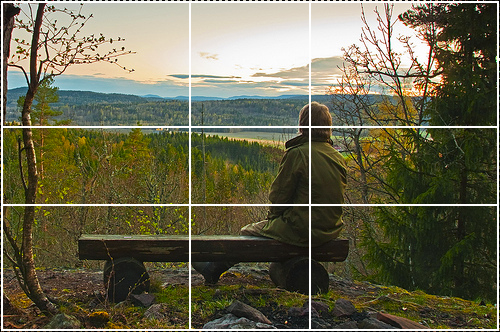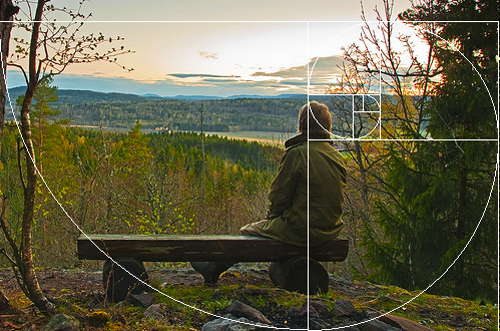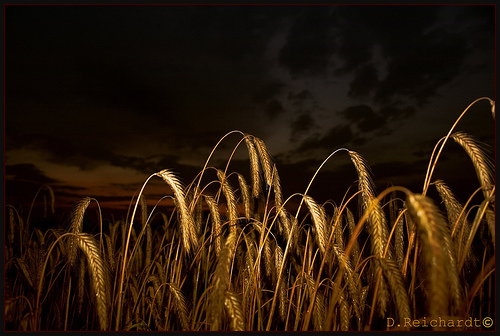
The “Golden Ratio” is naturally and aesthetically pleasing proportion which is popular in design and architecture amongst other fields. The golden ratio works wonders in drawing the human eye into the composition. It is the ratio of placement of various elements in the photograph. The golden ratio is a mathematical constant with its value equivalent to 1.61803… denoted by the Greek letter “phi”.
Golden ratio is 1:1.61803399
The golden ratio has been practiced by artists over time and has served their work of arts with appreciation — be it Mona Lisa by Leonardo da Vinci or the Egyptian pyramids. The golden ratio is best used when composing a scene comprised of two major contrasting planes. You can witness the implementation of golden ratio around you provided you consciously make an observation. You can practice golden ratio while shooting sunrise or sunset at horizon, golden sands (washed off by beach waters) or even while shooting flowers or portraits. The compositions are aesthetic and pleasing. You can consider to divide the plane horizontally, vertically or diagonally; thereby dividing the frame in two rectangles in the golden proportion.
Implementation Of Golden Ratio
Golden ratio is an advanced and complex composition technique. It is the rule designed for placement of elements on the frame in the aesthetic ratio which can be implemented in several ways; perhaps by using the golden mean, golden spiral or golden triangle.
Golden mean intends to divide the plane in three unequal parts (horizontally as well as vertically – as in the rule of thirds) such that two adjacent parts are in golden ratio and the subject is placed along the lines which divide the plane in golden proportion. The golden spiral on the other hand replicates the golden mean exemplified by the curves of the nautilus shell (exhibiting logarithmic spiral growth). The golden triangle is used for implementing the golden ratio diagonally; where the plane is divided into two equal halves diagonally and a perpendicular line is drawn from the opposite corners. The points where the lines intersect form the power points.
Here is an example of golden ratio viewed from the perspective of implementation of golden ratio in various ways.

In the following illustration, the golden mean is applied. The subject is placed along the points of intersection known as the power-points.

In this illustration, golden spiral is implemented to describe the golden ratio.

As a part of photo composition guide, Daniel Colegrove presents a tool for understanding the implementation of golden ratio. The Golden ratio tool comes in handy for understanding how the photographers apply golden mean, golden spiral and golden triangle to make the composition aesthetic and pleasing.
Applying golden mean, golden spiral and golden triangle can be tricky. The best thing is to implement the golden ratio by dividing the plane horizontally, vertically or diagonally; thereby dividing the frame in two rectangles in the golden proportion.
Golden Ratio Implemented Horizontally
Golden Mean Implemented Vertically
Golden Ratio Implemented Diagonally
It takes a little time getting used to composing in the golden ratio since the viewfinder is not very helpful in framing such a composition and an incorrect estimate will rather appear like an erroneous symmetry than an intended deliberate composition. Remember, the golden ratio itself doesn’t make a photograph beautiful, it only add to the composition by creating a level of interest. And as with any composition based effect, you can achieve this during the post-processing by cropping the edges of the photo to create or restore the golden ratio.




This article doesn’t do a great job of explaining how the golden ratio is used in the images shown, in my opinion. What do I do with the ratio? Do I divide elements in my frame with it (such as sky and water)? Or do I feature an arc (such as the bridge or curving blades of grass)? I’ve no clue. And the image for ‘Golden Ratio Implemented Vertically’ has left me more confused than before.
It’d be great if this article were to show before/after versions of an image, without and with the principle of the golden ratio implemented in the composition. That’d really help! :-)
I wonder how do you Implemented Diagonally in the last photo. Another photo with the lines would be very helpful.